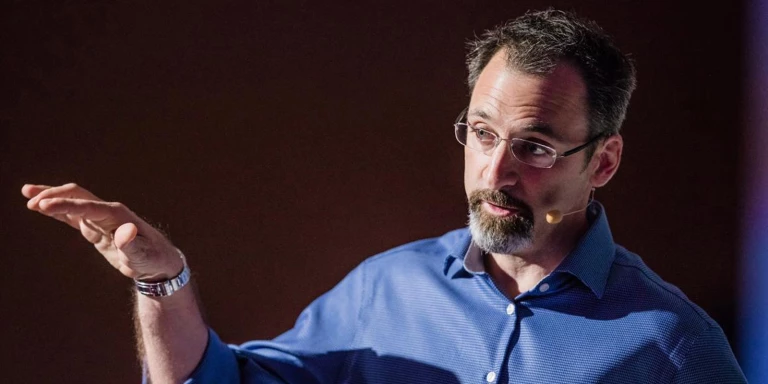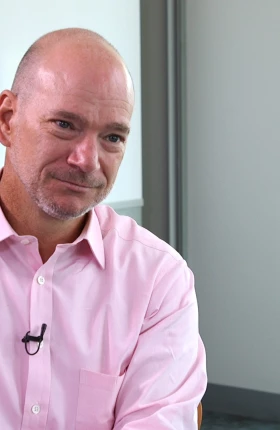Maurice Conti likes to talk Star Trek and flying squirrels—fitting topics for the chief innovation officer of what he affectionately calls a moonshot factory. Alpha, a unit of Telefónica, Spain’s largest telecom operator, is tasked with developing breakthrough technologies, but not just any technologies. Alpha only pursues projects with the potential to solve large societal problems and eventually become profitable businesses.
In his role, Conti roams widely through fields as diverse as artificial intelligence, virtual reality, and the future of work. A transplant from Silicon Valley, Conti now lives and works in Barcelona, when he is not visiting labs and research facilities to uncover the next new thing.
Conti recently sat down with Allison Bailey, the leader of Boston Consulting Group’s People & Organization practice. Their conversation covered squirrels, of course, but also the difference between technology development in the US and Europe, the future of management, and a technological solution to fake news (don’t hold your breath). Excerpts follow.
You talk and write about the augmented age. What do you mean by that?
We’re heading for a future where our natural human capabilities are going to be radically augmented in three ways: Computational systems will help us think. Robotic systems will help us make. And a digital nervous system will connect us to the world far beyond what our natural nervous system can offer.
Maurice Conti
Maurice Conti
Education
1992, bachelor’s degree in history, University of California, Santa Cruz
Career Highlights
2017–present, Alpha, chief innovation officer
2017–present, future/io institute, faculty
2010–2017, Autodesk, director of applied research and innovation
2001–2007, Autodesk, creative director
Outside Activities
2017–present, board member, the Luke Hand, a nonprofit developing a bionic hand for amputees
2011–2017, Muir Beach volunteer firefighter
To be clear, we are a long way from having anthropomorphic robots that cruise around and interact in a more or less human way. It’s really hard to create general intelligence, a flexible intelligence that can deal with different situations. Instead, we are going to get squirrels. A squirrel is vastly more intelligent than any of us in one particular dimension. A squirrel goes out and gathers thousands of acorns during the year and then hides them all over his territory. A year later, he can go back and find all of those acorns. You or I could never do this.
It’s really hard to create general intelligence, a flexible intelligence that can deal with different situations. Instead, we are going to get squirrels.
In this one narrow dimension, the squirrel can vastly outperform our own intelligence. And I think this should be the model when you think about how to apply technologies like AI, machine learning, and so forth. It’s about how you augment your own intelligence with these narrow superpowers. That’s cognitive augmentation.
But what about augmenting our bodies with robots? There’s been plenty of discourse about robots taking away jobs. In fact, we’ve been automating labor for more than 60 years. Industrial robots are nothing new. There is this joke about the factory of the future. The factory has two employees, a man and a dog. The man’s job is to feed the dog. The dog’s job is to keep the man away from all the fancy machines.
I think that’s totally the wrong way to think about it. Successful organizations in the future will figure out how to partner robots and humans to achieve things that neither can do by themselves. We should be using humans for the things they are good at, such as general awareness and walking around a factory floor making decisions, and using robots for what they are good at, which is precision and repetition.
How about augmenting our nervous system? Our natural human nervous system connects us to the world immediately around us really well. But the nervous system connecting us to the things that we make is rudimentary at best. A car doesn’t tell the city’s public works department that it just hit a pothole at 3rd and Broadway. A building doesn’t tell its architects whether or not the people in there like being in there or if they’re productive. With the Internet of Things, that will all change.
There’s a prediction that by 2030, half of our conversations will be with nonhumans, mostly with AI-powered chatbots. Because those conversations are digital, you can mine that data and get all kinds of insights. So I think right now is the time to think about how these technologies are going to affect the organizations of the future.
We’re going to achieve more than ever before as individuals and organizations by partnering with these technologies. Mahatma Gandhi said that the future depends on what you do today. This is the opportunity in front of us: to start building a future that we can all look forward to. That’s the augmented age.
This is the opportunity in front of us: to start building a future that we can all look forward to. That’s the augmented age.
When you think about the future with robotics, AI, and different ways of collaborating, what will be the role of the manager?
If you’re a manager, you don’t have anything to worry about. In fact, we need more managerial abilities and skills than ever before. Non-managerial skills will get automated first. With automation, we don’t actually automate jobs. We automate skills. If your job has one skill, I would be worried because that’s easy to automate.
Truck driving is already being automated because that is only one thing. If you work at McDonald’s, you have nothing to worry about. They do so many different things—taking orders, making French fries, fixing the bathroom. All of these are individually automatable, but the whole stack is very difficult. And a manager does an even bigger stack of different, more subtle tasks. I think the risk of automation is extremely low, and the importance and potential impact extremely high and growing.
What are the skills, capabilities, and mindsets that people need to have in the future?
I think those skills break down into two categories, hard skills and soft skills. On the hard side, certainly advanced IT is a no brainer. Soft skills will be increasingly important, but not at the exclusion of hard skills.
Curiosity and resilience are going to be keys for success in the future. You need curiosity to continue learning throughout your career, and you need resilience to be able to bounce back and keep moving forward.
What are organizations missing that would enable them to actually move more quickly into that future?
Futurists don’t actually predict the future. Their job is to figure out this range of possible futures and then identify strategies to take advantage of those possibilities. Accordingly, organizations should be paying attention. Have your head on a swivel. Reevaluate often because things are changing fast and changing at an increasing rate. Cast a wider net, and collaborate more
Can machine learning play a role in addressing the current political and social discontent?
We actually spent some time looking at how AI could fight fake news, disinformation, divisive information, and so forth. I was a little bit heartbroken.
On the tech side, it’s promising. There’s actually plenty we could do. On the human side, what we found out is people didn’t care. They did not want the truth. They weren’t going to pay for it. They weren’t going to go out of their way for it. People want to hear what they want to hear and are not actually that interested in the true truth. They want their own version of the truth.
Does it take policy? Does it take a government to step in and deploy technology that guarantees everything that’s coming from this body is truthful? I think that may be an option.
How do we define where it makes sense for technology to lead us and where humans should take the lead? For example, it may make sense for a building to have sensors, but not a toy like Barbie.
Tools should be in service of the humans who create them. So I think you should always be human led. It’s not what you see in Silicon Valley, where I used to work. In the Valley, it would be like, “Oh, look, we have this thing. It’s got blinky lights—cool. Let’s go build it. And it’s out on the market.”
Tools should be in service of the humans who create them.
In Europe, companies take a much more humanistic approach. The first questions would be, “Who cares, and why does anyone want it?” And the next questions would be “What role would it play in your life and society, and would that be a good thing?” These are questions that get asked up front. I would love to see more of those questions, especially in the tech centers like Silicon Valley.
At a personal level, parents need to understand the technology in their homes. I don’t think Alexa or an instrumented Barbie is that different from the TV being brought into the home 50 or 60 years ago.
What do you read to stay up to date with all these trends?
I read and watch a lot of science fiction. But I think the really valuable insight comes from being on the ground and talking to the people doing the work that you’re reading about. Really good intelligence doesn’t come from reading stuff that everyone has access to. It comes from going to labs and talking to people.
What often happens is you see, hear, and learn things that are two years away from being published. So suddenly you’re two years ahead of everybody else because you were in that lab, and they weren’t. You can also make connections between the thing they’re showing you that’s real today and the stuff they’re working on for the future.
How can organizations build digital and other skills in their employees?
It’s using technology to bring the curriculum, the material, to the person when they need it, in the way that they need it, in a way that’s digestible for that person. So you might like to digest your content in text, while I can’t retain what I read in a book, and so I need to absorb content visually and with sound.
In order to customize training, you need to be able to assess the person in real time or quasi real time. That’s really hard. You need some very powerful AI. But if I know what’s going on with you, where you’re coming from, and how your brain works, then I can develop the ability to deliver any content in any form. Then you have magic.
How would you define the augmented leader in a corporation?
Leadership is in large part about making good decisions quickly with probably not enough data. I think a lot of these technologies could help with that. It could give the leader a better picture of what’s happening, not just with hard data about what’s going on with the machinery of the organization, but also the human side. I think a lot of these technologies could help with that. It could give the leader a picture of what’s happening,
Generative design probably also has a role. You can give a system clear goals and constraints. For example, “I have these people, and I don’t want them to travel more than this distance.” That’s a perfect problem for a generative design algorithm. Tools like that, I think, could be a powerful way to increase the information that a leader has available to make decisions.
The BCG Henderson Institute is Boston Consulting Group’s strategy think tank, dedicated to exploring and developing valuable new insights from business, technology, and science by embracing the powerful technology of ideas. The Institute engages leaders in provocative discussion and experimentation to expand the boundaries of business theory and practice and to translate innovative ideas from within and beyond business. For more ideas and inspiration from the Institute, please visit Featured Insights.







